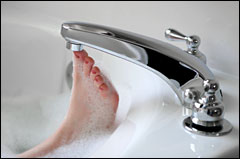Dear Umbra,
Your general drift has been to get us to focus on the big stuff instead of the little paper-or-plastic issues. So what’s the big picture of household water use and overuse? I have a clothes washer and a dishwasher, I wash dishes in the sink, I take showers and flush every time I pee, and my bathroom sink drips a bit. Which of these is my biggest issue, or is it something else I’m overlooking? How should I big-picture my water worries?
Rick Groshong
Tallahassee, Fla.
Dearest Rick,
Yeah, I say focus on the big stuff, but has anyone done the statistical analysis? If I’m not mistaken, I just wrote an article about vodka.

Eek! A leak!
Photo: iStockphoto
Over the years I’ve written articles about each of the water-using appliances you mention, which we can go back and revisit if we wish, but your question is a good one. If we held a gallons-take-all demolition derby, which appliance would win?
Let’s pilfer some numbers from … the Tallahassee city website! Your fine municipality tells us that a four-person household uses about 9,000 gallons of water per month, and gives us the top water consumers: toilets use 24 percent of the water, washing machines 22 percent, and showers 21 percent. The American Water Works Association seems to have the same statistical source and so can finish off our numbers: faucets use 15 percent, leaks 14 percent, baths 1.7 percent, dishwashers 1.5 percent.
What you should do with this information is going to depend a bit on your own watery habits, and on the efficiency of your household. There are easy behavioral changes you can make that will reduce your water use whether or not your appliances are efficient, and since these are free — money-saving, in fact — let’s put them first on the list. Obviously, if you wash the dishes by turning the hot water spigot full blast and running it continuously during the 10 minutes it takes to clean up after dinner, there’s room for improvement. If you already have a low-flow toilet and are not willing to let it mellow, there’s nothing you can do there. Take shorter showers, turn the sink off while brushing your teeth, use your dishwasher instead of your kitchen sink if you have enough dishes to make it worthwhile, and only run full loads through the clothes washer.
Looking at our numbers above, I say fixing any leaks is our number one big-picture item after we change our wasteful habits. Replacing inefficient appliances will reduce water use for that appliance, but fixing all leaks ends that waste of water entirely, cutting our usage by 14 percent. Another statistic: one drop per second adds up to 2,700 gallons a year. You can see your leaky faucet; there may be other leaks you cannot see, such as within the toilet or — mon dieu — in a pipe. After fixing your faucet leak, go find the water meter (everyone’s water service website should have instructions on finding the meter and learning to read it — here’s one example). Do two meter readings two hours apart without using any water between, and you’ll know if you have a leak.
Check your meter before starting this project, in fact. Measure one week of water use, then change your habits for a week and see what the impact is; then fix the leaks and check again. During week four, change the next big item for your own personal home — probably the toilet, based on the above numbers and your own narrative. If you are going from a five-gallon flush to a 1.6, that’ll make a big difference. But only you know your home appliances well enough, and maybe your big difference will be in the showerhead. That would be lucky, because a low-flow showerhead is quite a bit cheaper than a new toilet. You can evaluate which one to prioritize either using the water meter — you know, one day without flushing the toilet, another without using the shower, see which uses more water — or by figuring the gallons per use and multiplying by times used. The toilet should have the gallons per flush on it, the shower you’ll probably have to measure. Here’s a page with a handy comparison of less-efficient and more-efficient appliances, so you can see the benefits of replacement.
Good luck, and I hope you don’t have any leaks.
Flushingly,
Umbra

